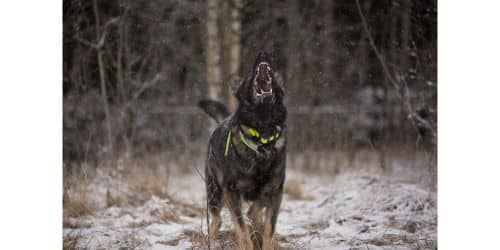As dog owners, we want our pets to be happy and healthy, yet they sometimes suffer from health difficulties such as eye disorders. Conjunctivitis is a common eye illness that affects dogs of all breeds and ages. In this blog post, we’ll look at conjunctivitis in dogs, including its causes, symptoms, and treatment options. Understanding this ailment will allow you to detect symptoms early on and provide prompt care for your cherished pet.
What is Conjunctivitis?
Conjunctivitis is an inflammation of the conjunctiva, which is the thin and transparent tissue that covers the white area of the eye and lines the inside of the eyelids. This inflammation can affect one or both eyes and is caused by a variety of circumstances.
Causes of Conjunctivitis in Dogs
There are a number of causes of conjunctivitis in dogs, including allergies, infections (bacterial, viral, or fungal), irritants, foreign bodies, and underlying medical conditions. Allergies, which are triggered by environmental allergens such as pollen, dust mites, or particular foods, are a common cause of conjunctivitis. Bacterial, viral (such as canine distemper or canine adenovirus), or fungal infections (such as Aspergillus or Candida) can all occur. Irritants such as chemicals, smoke, or pollution, can also cause conjunctivitis as they irritate the delicate tissues of the eye. In some circumstances, anatomical anomalies, dry eye syndrome, or immunological illnesses can also contribute to the development of conjunctivitis.
Symptoms of Conjunctivitis in Dogs
Recognizing conjunctivitis symptoms is critical for early detection and treatment. Redness, swelling, discharge (clear, yellow, or greenish), excessive crying, squinting, scratching or pawing at the eye, sensitivity to light, and changes in the dog’s behavior or food are all common warning symptoms. Conjunctivitis can cause crusting around the eyes, corneal ulcers, and even visual impairment in extreme cases. If you see any of these signs, contact your veterinarian immediately for a comprehensive diagnosis and treatment plan.
Diagnosis and Veterinary Care
When it comes to conjunctivitis, determining the underlying reason and tailoring treatment accordingly is crucial. Seeking veterinarian care is critical to your dog’s health and well-being.
#1. Veterinary Examination
When you take your dog to the vet, they will perform a complete examination of the dog’s eyes, which may involve a visual inspection, an assessment of the surface and structures of the eye, and a search for any foreign objects. They may also do tests such as a Schirmer tear test, which monitors tear production, or collect an eye discharge sample for further study. These steps assist the veterinarian in determining the etiology of conjunctivitis and developing an effective treatment plan.
#2. Treatment Options
Conjunctivitis in dogs is treated differently depending on the underlying reason. Different techniques, such as topical drugs (eye drops or ointments) to reduce irritation, combat infection, or offer lubrication, may be prescribed by your veterinarian. Antihistamines or corticosteroids may be prescribed to relieve symptoms of allergic conjunctivitis. It is critical to follow your veterinarian’s recommendations for dosage, frequency, and duration of treatment. Regular check-ins may be required to monitor your dog’s progress and make any necessary changes to the treatment plan.
Prevention and Home Care
Aside from medical care, you may help your dog’s recovery and avoid future episodes of conjunctivitis at home.
#1. Correct Eye Hygiene
Maintaining excellent eye hygiene is critical for preventing and treating conjunctivitis. According to your veterinarian’s instructions, gently clean the eyes of your dog with a clean, wet cloth or sterile eye wipes. Avoid directly touching the surface of the eye or using harsh chemicals that may irritate the eyes.
#2. Environmental Management
If allergies are the root cause of conjunctivitis in our dogs, limiting your exposure to allergens can help. Keep your dog’s living space clean and free of dust, mold, and pollen. Vacuum routinely, wash bedding regularly, and consider utilizing air purifiers or allergen-resistant furniture covers. Furthermore, avoid exposing your dog.
Soothing Remedies for Conjunctivitis
In addition to medical care, there are several calming remedies you may try at home to assist in relieving your dog’s discomfort from conjunctivitis.
#1. Warm Compresses
By lowering inflammation and calming the eye, using a warm compress on your dog’s affected eye can bring relief. Warm a clean washcloth and gently press it on the eye for a few minutes. To avoid inflicting burns or discomfort on your dog, make sure the compress is warm rather than hot. Repeat this practice several times per day to help relieve symptoms.
#2. Herbal Eyewash
Certain herbal eyewashes can help reduce inflammation and pain caused by conjunctivitis. Chamomile and calendula are two herbs with calming effects. Make an herbal eyewash by steeping a tea bag or dried flowers in boiling water and letting it cool fully. Strain the liquid and apply the herbal infusion to your dog’s eye with a clean dropper or cotton ball. To avoid further discomfort, use careful application.
Protective Measures for Dogs with Conjunctivitis
Conjunctivitis is contagious, especially when caused by an infection. Taking precautions will help prevent the spread of the disease and aid in your dog’s recovery.
#1. Isolation
If your dog has contagious conjunctivitis, you must isolate them from other dogs to prevent the infection from spreading. Keep them away from public places, dog parks, and daycare centers until they have recovered completely. To reduce the chance of transmission, avoid close contact with other animals during this time.
#2. Hygiene Practices
When caring for a dog with conjunctivitis, it is critical to practice good cleanliness. After handling your dog’s eyes or delivering medications, properly wash your hands. To avoid cross-contamination, use separate towels, washcloths, or tissues to clean each eye, and avoid using the same cloth on both eyes.
Complications and Potential Risks
While conjunctivitis in your dog is usually curable and controlled, there are certain difficulties and risks linked with it.
#1. Corneal Ulcers
Corneal ulcers can develop if left untreated or if the underlying cause of conjunctivitis is not addressed. Also,Corneal ulcers are open sores on the clear outer layer of the eye’s cornea. These ulcers can be unpleasant and, if not treated appropriately, can lead to severe eye difficulties.
#2. Secondary Infections
Conjunctivitis can produce an environment ripe for subsequent infections. Bacteria and fungi may exploit the inflamed and fragile eye tissues, resulting in more severe infections. Secondary infections might delay healing and necessitate extra treatment.
Prevention Tips
While it is not always possible to avoid conjunctivitis in dogs, there are several precautions you may take to reduce the risk.
#1. Regular Eye Examinations
Schedule frequent check-ups with your veterinarian, which should include a thorough eye examination. Regular screenings can aid in the early detection of conjunctivitis and other eye problems, allowing for rapid treatment and prevention of complications.
#2. Good Hygiene Practices
Maintain good hygiene to reduce your dogs chances of getting conjunctivitis. Keep your dog’s face clean by gently cleaning around the eyes with a moist towel or using veterinarian-recommended specialty eye wipes. Trim the hair around the eyes regularly to avoid irritation and debris accumulation.
The Importance of Early Intervention
When it comes to conjunctivitis in dogs, early intervention is critical. Prompt detection and treatment can help relieve discomfort, prevent complications, and hasten recovery.
#1. Timely Veterinary Care
If you feel your dog has conjunctivitis, you should take him to the vet as soon as possible. An expert diagnosis will determine the underlying reason and direct the best treatment plan. Delaying treatment might exacerbate the illness and make it more difficult to control.
#2. Follow Treatment Plans
Once your veterinarian has established a treatment plan, it’s important to follow their instructions diligently. To monitor your dog’s progress, administer medications as directed, maintain proper cleanliness habits, and attend follow-up appointments. Throughout the treatment procedure, open communication with your veterinarian is essential.
Conjunctivitis in dogs is a bothersome and potentially dangerous condition. You can give essential treatment and support to your beloved pet by understanding the causes, detecting the symptoms, and obtaining timely veterinarian care. Remember to exercise excellent hygiene, take preventive steps, and seek expert assistance when necessary. With your help, your pet can recover from conjunctivitis and enjoy healthy, sparkling eyes once more.
When to Seek Veterinary Help
While conjunctivitis may typically be treated at home, there are times when your dog needs veterinary care.
#1. Persistent or Severe Symptoms
Consult your veterinarian if your dog’s symptoms persist or worsen despite home care and early therapy. Redness, swelling, discharge, or indications of discomfort that persist may signal a more serious underlying problem or the need for a different treatment approach.
#2. Changes in Vision or Behavior
If you detect any changes in your dog’s eyesight, such as bumping into things or having difficulties traversing familiar surroundings, you should seek veterinarian care right away. A professional should also be consulted if there are any notable changes in your dog’s behavior, eating, or overall well-being.
How do you treat conjunctivitis in dogs?
Treatment focuses on the underlying problem and may include both topical and oral medications. Antibiotic eye ointments or drops are frequently administered. Some dogs will be given anti-inflammatory medications, such as topical steroids.
Can dog conjunctivitis heal on its own?
Yes, while some cases of dog conjunctivitis may be cured on their own, they may not be completely healed without medicine. Instead of hunting for home treatments, take your dog to the vet as soon as possible.
How did my dog get conjunctivitis?
Allergies, irritation from foreign bodies, viral infections, tumors in the eye region, breed-specific conditions such as nodular episcleritis in Collies, tear film deficiency, abnormalities of the eye, obstructed tear ducts, and parasitic infections can all cause this condition in dogs.
How do you treat conjunctivitis in dogs at home?
A cold compress, as with any inflammation, may provide much-needed relief. Use a gentle, moist washcloth to rub against your dog’s closed eyelids for 3 minutes several times per day. Artificial tears, which are commonly administered to dogs suffering from Dry Eye Syndrome, contain a lubricant that moisturizes your dog’s eyes.
Can I give my dog amoxicillin for conjunctivitis?
The drug kills bacteria by interfering with their cell wall formation and is frequently prescribed by veterinarians to treat bacterial infections in pets. “In my experience, amoxicillin is a safe antibiotic when appropriately prescribed by a veterinarian and used by the pet owner,” Dr.
Can you give a dog salt water for conjunctivitis?
Yes. Rinse your dog’s eyes and surrounding region with a basic saline solution, which may be purchased from a veterinarian or pharmacy or created at home by dissolving a teaspoon of salt water in a cup of warm water. Carefully insert a cotton ball into the corner of your dog’s eye and wipe away discharge from surrounding the eye.
Does conjunctivitis hurt dogs?
Pink eye, commonly known as conjunctivitis, manifests in dogs in the same way as it does in humans. This common eye infection, characterized by red or pink irritated eyes and frequently accompanied by discharge, is not a pleasant experience for dogs or owners, but it is fortunately treatable in most cases.
How long does dog conjunctivitis last?
In the case of allergy or fungal infections, recovery time is usually only a few days, however, some viral or bacterial infections might take up to three weeks to resolve.
Can dog conjunctivitis spread to humans?
Furthermore, some kinds of dog conjunctivitis (typically bacterial) can be transmitted to humans, albeit this is quite rare. Anyone who comes into contact with an infected dog should thoroughly wash their hands to prevent the infection from spreading to other animals or themselves.
Which eye drops are for conjunctivitis?
Chloramphenicol. Chloramphenicol is the most often used antibiotic and is available as eye drops. It is available in pharmacies without a prescription to treat bacterial conjunctivitis.
Conclusion
Conjunctivitis is a frequent eye condition in dogs that can cause discomfort and impair their quality of life. Recognizing the origins, symptoms, and treatment choices is critical for providing appropriate care and protecting the well-being of your dog. Remember to consult your veterinarian for an accurate diagnosis and treatment plan. With quick veterinary care, adequate home care, and preventive measures, you can help your pet recover from conjunctivitis and keep their eyes healthy and happy.
Related Articles
- DOG MAMMARY TUMOR REMOVAL COST
- WHY DO CATS WAG THEIR TAILS WHILE LYING DOWN?
- CAN CATS GET A COLD? All You Need to Know
- How To Treat A Limping Dog At Home
- Medicine For Dog Ear Infection: Which One Is Best For Your Dog?






